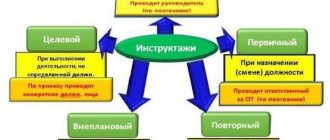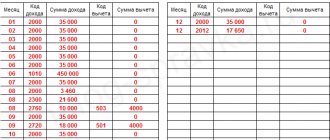What influences the way a company organizes labor protection
The method of organizing OT depends on:
- level of mechanization and automation of the technical process;
- ergonomic indicators (work and rest schedule, emotional and physical stress of workers);
- aesthetic requirements for the working environment;
Occupational Safety and Health
- sanitary factors (air quality, water quality, gas pollution, noise, lighting);
- organizational abilities of management (work regime, form of its organization, discipline);
- the severity of work, emotional and physical stress of employees;
- social factors;
- natural and climatic factors;
- economic factors.
The operating conditions of an enterprise directly affect how labor protection is organized.
Organization of labor protection in production
What is the mandatory minimum of labor protection in every organization?
Labor protection and fire safety at the enterprise
A newly formed enterprise is required to have at its disposal the following minimum list of documents on occupational safety. You will need papers regarding labor protection. Personnel documents will also be required. An enterprise cannot start operating without:
- staffing table;
- internal regulations;
- orders for granting vacations and their schedule;
- work books and employment contracts;
- instructions that all employees are required to study;
- personal cards of workers (the individual entrepreneur may not have them);
- documents on the procedure for issuing wages.
It is necessary to have documents related to electrical safety:
- a journal for recording the knowledge and standards acquired by the employee in the field of working with electrical installations;
- a list of professions and positions, as well as jobs to which the electrical safety group is assigned.
Documentation regarding fire safety will also be required.
Most of the documents are available in finished form; the management of the enterprise can only interpret them for their own production.
Documentation
Cost of occupational safety audit
The cost of services for auditing working conditions for safety and health varies from 20 thousand to 50 thousand rubles*, depending on the enterprise. The cost is affected by:
- the amount of work ahead;
- assigned tasks;
- area of conduct;
- number of staff;
- complexity and volume of documentation;
- specifics of the enterprise.
For example, an analysis of the necessary documentation, taking into account the issuance of an act and recommendations, will cost 8,000 rubles. Inspection of the premises system for compliance with labor legislation and sanitary and hygienic standards costs 15 rubles. for 1 m² of premises up to 500 m² and 10 rubles. with an area of more than 500 m².
If facilities comply with all legal requirements for the protection of working conditions, the risks of traumatic situations are reduced to zero. Also, do not neglect regular special assessments of working conditions. According to the law, such unscheduled assessments must be carried out before the expiration of six months from the day the new workplaces were put into operation.
*Prices are current as of July 2021.
vote
Article Rating
Features of labor protection at manufacturing enterprises
Occupational safety and health at catering establishments
Labor protection at manufacturing enterprises has the following features:
- this issue is under the jurisdiction of the organization’s management (Article 221 of the Labor Code of the Russian Federation);
- if a company has more than 50 employees, a separate division responsible for labor protection is created on its basis (Article 217 of the Labor Code of the Russian Federation);
Important! One person appointed by the manager may be responsible for labor safety measures developed from scratch according to the step-by-step instructions of 2021.
Labor protection from scratch in the organization
For novice occupational safety specialists and those who want to understand this topic, it can be difficult to correctly sequence what to do first and what is best left for later. Where to start working on labor protection?
Everyone knows that if you take on all the tasks at once, you will not complete a single one. And when there are thoughtful step-by-step instructions, moving becomes not only easier, but also faster. And yet, what should a labor protection specialist know first?
Let me remind you that the previous 5 steps of the article in the section “Occupational Safety Step by Step” can be read here. So we will immediately start with step 6, continuing the instructions for beginners.
Why is labor protection needed in a manufacturing enterprise?
Labor protection at the enterprise: rules, organization
Labor protection at an enterprise is necessary:
- to reduce the risk of occupational injuries, including those incompatible with life;
- improving working conditions, which automatically reduces the number of paid sick leaves and the amount of compensation for harm;
- to reduce plant downtime due to the absence of injured employees.
For this purpose, every enterprise implements an occupational safety management system.
Sample list of documents
Basic requirements of regulatory documents on labor protection for the employer
When preparing documents on labor protection, it is necessary to take into account the requirements that legislation imposes on the management of the enterprise:
- ensuring the safety of workers during the operation of buildings and structures, carrying out various types of work, and when using tools;
- use of individual and collective protective equipment for workers subject to certification;
- compliance with the work and rest schedule of employees;
- providing training in safe work methods and techniques, first aid, including on-the-job training;
- preventing employees who have not completed labor safety training and knowledge testing from working;
- informing employees about working conditions, labor protection in the workplace, possible risks, personal protective equipment and provided compensation;
- taking measures to prevent emergency situations, ensuring the safety of workers when they occur;
- investigation and recording of industrial accidents, cases of occupational diseases;
- sanitary, medical and preventive services for workers;
- social insurance of workers against accidents and occupational diseases;
- informing employees about labor protection requirements;
- development of documents on labor protection in agreement with the primary trade union organization, the Labor Council.
Occupational safety management system in the organization
The OT management system means:
- organizing training classes and allocating appropriate training hours to train employees in occupational safety standards and regulations;
- equipment of the workplace in accordance with legal norms;
- creating working conditions that would not have a negative impact on the employee’s body;
- organizing the supply of PPE to all employees;
- working on plans to deal with emergency situations that result in employee injury;
- measures to provide workers with necessary treatment.
The list of measures to improve occupational health is being introduced gradually.
Planning and financing of occupational safety measures
Organizations, regardless of their form of ownership and number of staff, are obliged to ensure the implementation of measures to improve workplaces. Financing for these procedures must be at least 0.2% of the total cost of production.
Note! When planning, you should take into account the possibility of returning 20% of the difference between insurance payments made for the year and accrued insurance premiums. These funds can be reimbursed provided they are used for sanatorium treatment, medical examinations, special assessments, and for the purchase of personal protective equipment
Sample order on labor protection at an enterprise
When choosing a person responsible for labor safety, the head of the enterprise is obliged to sign the corresponding order. It is compiled according to a generally accepted model by any competent employee of the company and contains:
- information about the enterprise;
- information about the responsible person;
- list of responsibilities of the responsible person.
Order
The document ends with the number and date of its preparation.
Important! The order can be printed or issued by hand; it does not have to be certified with a seal (an individual entrepreneur may not have a seal).
Compiling a list of harmful and dangerous production factors
When taking into account harmful and dangerous factors, they study:
- features of equipment, materials and raw materials with which workers come into contact;
- the results of the checks performed;
- results of tests and studies for the presence of harmful or dangerous factors;
- information about previous accidents associated with the harmful effects of production factors on workers;
- suggestions received from employees.
Important! A correctly compiled list of factors harmful to employees of an enterprise does not exclude the need to measure the time of their impact on individuals in a particular profession.
After taking into account all the factors, they take a list of the organization’s employees and, based on information about the profession and position of each employee, make a list of what can be considered harmful to health and life, including, for example, radiation from a computer monitor, lack or excess of light, loud sounds.
Action plan for organizing labor protection
An action plan for organizing occupational safety usually consists of the following points:
- event numbers;
- names;
- implementation deadlines;
- columns to indicate the responsible person;
- lines to indicate the cost of the work performed.
The plan may be part of an employment contract concluded between the employer and employee or an independent document. The list of measures necessary to improve the quality of occupational safety is contained in Order of the Ministry of Labor No. 181n. To implement it you will need:
- Create an OT management system at the enterprise.
- Appoint a person responsible for occupational safety.
- Issue an OT Order.
- Adopt an Order on the appointment of persons responsible for occupational safety.
- Approve OT instructions.
Important! Responsible persons are required to implement activities in accordance with the plan.
Who can conduct an occupational safety and health audit?
Depending on the type of audit, members of the audit committee are selected. If there is an internal audit, the auditors are appointed by management. They can be employees who are specialists in the required field. If we are talking about an external inspection, then the commission should include specialists from third-party inspection institutions.
Requirements that each member of the audit committee must meet:
- higher or secondary specialized education;
- work experience in this field for at least three years;
- availability of a training program for an auditor in a minimum amount of 40 hours;
- the presence in the last three years of four full inspections (20 hours each) under the supervision of a more experienced worker.
Organization of personnel training
All individuals working in the organization are required to periodically pass an occupational safety exam. To this end:
- general briefings are conducted for all employees who have just joined the company (one time);
- special briefings (once a year) for certain categories of employees (regularly).
In total you need to go through 5 types of instructions:
- introductory (when applying for a job);
- primary (conducted by the head of the structural unit);
- repeated (once every 3 months);
- target (if the technician needs to perform a specific job);
- unscheduled (if required by the inspector).
If necessary, employees of the organization are sent to OT training. After conducting the briefing and passing the safety knowledge (HS) exam, employees sign in the logbook for registering the briefing.
Important! 40 hours are allocated for training a manager, and at least 20 hours for training ordinary workers.
Labor protection in the organization on its own. Step by step guide
I decided to structure the information and create a step-by-step guide to organizing work on labor protection.
Target audience: novice occupational safety specialists or entrepreneurs who do not have the funds (or desire to spend them) either on an occupational safety specialist or on outsourcing. After all, it is known that if the number of employees is no more than 50, you can legally do without it.
Goal: to cover everything important and a little unimportant in order to avoid sanctions during inspections and (or) accidents.
The algorithm will be supplemented and corrected. Write about any inaccuracies you notice and your suggestions in the comments.
Let's start with the distribution of responsibilities, election of an authorized person and training of managers and specialists in labor protection
Organization structure
Not necessary. Not covered by regulatory requirements
We are preparing this document for our convenience. It is not always available in the organization, and according to the staffing table it can be difficult to understand who reports to whom and is responsible for whom.
Order on the appointment of a person responsible for labor conditions and safety
sample order (for yourself)
sample order (for managers)
Art. 22, 212 Labor Code of the Russian Federation
The employer can appoint himself as responsible (if the organization is small) or whomever he deems necessary. In each structural unit, as a rule, its head is appointed responsible. We keep in mind that all these individuals will need to be sent for occupational safety training to a training organization .
Order on the appointment of a person responsible for conducting labor safety briefings
sample order (for yourself)
sample order (for managers)
clause 2.1.1. Resolutions of the Ministry of Labor of the Russian Federation and the Ministry of Education of the Russian Federation dated January 13, 2003 No. 1/29
GOST 12.0.004-2015. Interstate standard. System of occupational safety standards. Organization of occupational safety training. General provisions
If the organization has a labor protection specialist, then responsibility for conducting induction training rests with him. We place responsibility for conducting workplace briefings on the heads of structural units. In micro-organizations, the director can appoint himself responsible for everything. It would not be amiss to list professions (positions) in the order.
Election of a labor protection commissioner
Download the election protocol here
There is no mandatory regulatory requirement, but this is one of many cases when it is easier to acquire one rather than the other way around.
The participation of the commissioner is highly desirable as part of various commissions, as well as for the approval of many local documents. You can read more here.
Training of managers and occupational safety specialists
upon admission to work, during the first month, then - once every 3 years
clause 2.3.1. Resolutions of the Ministry of Labor of the Russian Federation and the Ministry of Education of the Russian Federation dated January 13, 2003 No. 1/29
We send all those involved in the first two orders, as well as the elected representative for labor protection, to undergo training in labor protection at a specialized organization
To organize labor safety briefings, you need to perform the following set of measures:
Development of labor protection instructions
Read more about the development of labor safety instructions here
Art. 212 Labor Code of the Russian Federation
clause 5.1. Methodological recommendations for the development of state regulatory requirements for labor protection (annex to the Resolution of the Ministry of Labor of Russia dated December 17, 2002 No. 80)
Labor protection instructions are developed for each position (profession) or type of work performed.
All labor safety instructions are approved by the manager and coordinated with the labor protection officer.
Labor safety instructions are reviewed at least once every 5 years
Journal of labor safety instructions for workers
Sample filling and journal form
adj. 9 Methodological recommendations for the development of state regulatory requirements for labor protection (Appendix to the Resolution of the Ministry of Labor of Russia dated December 17, 2002 No. 80)
You can print the magazine yourself or buy a ready-made one. We include all current labor safety instructions in this journal.
Logbook for issuing labor safety instructions for workers
adj. 10 Methodological recommendations for the development of state regulatory requirements for labor protection (Appendix to the Resolution of the Ministry of Labor of Russia dated December 17, 2002 No. 80)
In this journal we record the issuance of instructions to heads of structural divisions.
List of labor safety instructions
clause 5.9. Methodological recommendations for the development of state regulatory requirements for labor protection (annex to the Resolution of the Ministry of Labor of Russia dated December 17, 2002 No. 80)
Each department head, in addition to labor safety instructions, must have a list of them
Induction training log
Sample filling and journal form
clause 2.1.2. Resolutions of the Ministry of Labor of the Russian Federation and the Ministry of Education of the Russian Federation dated January 13, 2003 No. 1/29
clause 8.4. GOST 12.0.004-2015
We buy a magazine or print it ourselves and record introductory briefings with all newly hired employees in it.
On-the-job training log
Sample filling and journal form
clause 2.1.3. Resolutions of the Ministry of Labor of the Russian Federation and the Ministry of Education of the Russian Federation dated January 13, 2003 No. 1/29
clause 8.4. GOST 12.0.004-2015
We also buy or print them ourselves, and distribute magazines to heads of structural divisions with explanations about the procedure for maintaining them.
Labor safety induction program
clause 2.1.2. Resolutions of the Ministry of Labor of the Russian Federation and the Ministry of Education of the Russian Federation dated January 13, 2003 No. 1/29
clause 8.6. GOST 12.0.004-2015
The introductory briefing must be carried out according to the program, so we print it out, approve it and agree on it.
Initial training program on labor protection in the workplace
clause 2.1.4. Resolutions of the Ministry of Labor of the Russian Federation and the Ministry of Education of the Russian Federation dated January 13, 2003 No. 1/29
clause 8.7. GOST 12.0.004-2015
Unlike the introductory briefing program, we develop a primary briefing program for each profession/position
Occupational safety training in your commission
Labor protection training for all employees of the organization
As a result, we should have the following documents:
Order on the creation of a commission to test knowledge and labor protection requirements
Training programs on labor protection for managers and specialists, as well as blue-collar workers
Minutes of the meeting of the commission to test knowledge of labor protection requirements for workers
Occupational safety certificates
Art. 225 Labor Code of the Russian Federation
clauses 2.2.1, 2.3.1 of the Resolution of the Ministry of Labor of the Russian Federation and the Ministry of Education of the Russian Federation dated January 13, 2003 No. 1/29
managers and specialists - at least once every 3 years; workers - at least once a year
If we have at least three people trained in labor protection in a training organization, we can create our own commission to test knowledge and labor protection requirements. Read about how to organize this here .
Preparation of training programs
The educational process is impossible without properly developed instructions and training programs relating to each profession and type of work performed. Ready-made programs can be purchased from companies that compile them.
Ready-made training programs on labor protection
Employees’ knowledge is tested using ready-made training programs, after which an inspection protocol is drawn up. Employees must undergo training annually or every time there is a change in profession, position, after a transfer or break in work. Management is retrained once every 3 years.
Does a company need a labor protection service?
If the enterprise has more than 50 employees, then it is necessary to create a labor protection service or introduce the position of a labor protection specialist in accordance with Article 217 of the Labor Code of the Russian Federation.
If the company has up to 50 employees, then such a service is not needed. In this case, the functions of a labor protection specialist can be performed by: - an individual entrepreneur (personally); - Head of the organization; - employee authorized by the employer; - organization - outsourcer.
These persons must be trained upon entering a job, and then once every 3 years in training organizations or in the organization itself, if there is a commission for testing OT knowledge consisting of at least 3 people.
Documents on labor protection at the enterprise
The enterprise must have the following documents on occupational safety:
- Labor Code of the Russian Federation;
- Orders of the Ministry of Labor;
- safety instructions, both general and specific (for each type of work);
- an order for the enterprise regarding the appointment of persons responsible for organizing labor protection;
- a list of employees who are required to undergo regular medical examinations;
- a list of professions and types of work that are particularly dangerous (there may not be any);
- occupational safety action plan;
- briefing log;
- journal for issuing personal protective equipment.
The presented list of documents can be supplemented in accordance with the order of the organization’s management or at the request of the inspection person.
Plan
What are the tasks of the labor protection service?
Organization of labor protection at an enterprise is a set of measures initiated by the management of the enterprise and the labor protection service.
In turn, the labor protection service carries out its activities in cooperation with other divisions of the organization, the labor protection committee (commission), authorized (trusted) persons for labor protection of trade unions or other representative bodies authorized by employees, the labor protection service of a higher organization (if it availability), as well as with federal executive authorities and the executive authority of the relevant constituent entity of the Russian Federation in the field of labor protection, state supervision and control bodies over compliance with labor protection requirements and public control bodies.
At the initiative of the employer or employees, a labor safety committee is created, which includes representatives of the employer and representatives of the elected body of the primary trade union organization or other representative body of employees. The labor protection committee (commission) organizes joint actions of the employer and employees to ensure the requirements for organizing labor protection, preventing industrial injuries and occupational diseases, and also organizes inspections of labor conditions and labor protection in the workplace and informing workers about the results of these inspections, collecting proposals for section of the collective agreement (agreement) on labor protection (Article 218 of the Labor Code of the Russian Federation).
The main tasks of the occupational safety service according to the Recommendations are: - development of an occupational safety management system in the organization to ensure that employees comply with occupational safety requirements; — control over employees’ compliance with laws and other regulatory legal acts on labor protection, collective agreements, agreements on labor protection, and other local regulatory legal acts of the organization; — organization of preventive work to prevent industrial injuries, occupational diseases and diseases caused by production factors, as well as work to improve working conditions; informing and consulting the organization’s employees, including its manager, on labor safety issues; — study and dissemination of best practices in labor protection, promotion of labor protection issues.
Organization of labor protection implies control of the head of the enterprise's labor protection service. Control is also carried out by the labor protection service of a higher organization (if there is one), the executive authority of the relevant constituent entity of the Russian Federation in the field of labor protection, and state supervision and control bodies over compliance with labor protection requirements.
The head of the organization is also responsible for the activities of the service. Service employees are responsible for fulfilling their job responsibilities as defined by the regulations on the labor protection service and job descriptions.
Why is it beneficial to seek help from specialized companies?
It is possible to involve third-party organizations in assessing working conditions and drawing up programs for training workers in occupational safety standards and conducting such training; this is beneficial. To the employer:
- there is no need to keep a specialist on staff who could train the rest of the staff;
- there is no need to allocate a special place where lessons could take place.
Important! A specialized company usually guarantees that the employee undergoes all necessary training. Upon completion of the SOUT or training process, the customer is issued a corresponding report.
What is the responsibility for violations in labor protection organizations?
If the head of an enterprise has not taken measures to train employees in occupational safety standards, he is responsible for this before the law.
Criminal liability
This type of liability occurs if an accident occurs at the enterprise due to non-compliance with safety regulations, and the person responsible is caught in it. They are held accountable under Art. 143 of the Criminal Code of the Russian Federation. The culprit of the incident is punished depending on the degree of guilt and the harm caused. The court has the right to fine the guilty person in the amount of up to 400 thousand rubles*, send him to forced, compulsory or correctional labor, and restrict freedom for up to 1 year (possible loss of license for the same period).
If people died, the term of imprisonment is increased to 4 years, and the period of disqualification to 3 years.
Administrative responsibility
They are brought to administrative responsibility under Art. 2.4 and art. 5.27 Code of Administrative Offenses of the Russian Federation. Responsible persons are fined or forced to cease activities until all labor safety problems discovered by the inspector are eliminated.
The legislative framework
Responsibility for violations
Control over the state of technosphere security is constantly carried out by the state. Occupational health and safety at work is subject to the supervision of various ministries and departments, the main one of which is the Federal Service for Labor and Employment. Main areas of monitoring:
- supervision and control over compliance with labor protection legislation;
- supervision and control over the application of regulations on compensation for harm caused at work;
- fulfillment of collective agreements and obligations for social insurance of employees.
For violations in the field of labor protection, employees, officials and legal entities are brought to administrative responsibility under 5.27.1 of the Code of Administrative Offenses in the form of a warning or a fine of up to 200,000 rubles. For safety violations identified by regulatory authorities, the organization has the right to close for up to 90 days.
For violations that led to the death of workers, you will have to answer under Article 143 of the Criminal Code of the Russian Federation, the sanctions of which include fines of 400,000 rubles or imprisonment for up to 4 years.










